Abstract
Patients with AIDS commonly develop disseminated infections with Mycobacterium avium (MA) but not its close relative, M. intracellulare (MI). In non-AIDS patients who have these infections, the two species are about equally distributed. The higher incidence of infection with MA than with MI in AIDS patients might be due to the selective susceptibility of these patients to MA. This possibility was tested by comparing the abilities of MA and MI to infect and replicate in cultured macrophages from normal subjects and from patients with AIDS-related complex or AIDS. The macrophages were cultured in medium supplemented with 1 or 5% normal or patient sera or with 1% defined serum substitute. Replication of MA (serovar 4) or MI (serovars 16 and 17) in the macrophages was measured by CFU counts made from lysed samples of the macrophages taken at 0,4, and 7 days after macrophage infection. MA and MI in infected normal macrophages which were cultured in normal serum replicated in these macrophages at similar rates. MA but not MI multiplied abnormally rapidly in patient macrophages cultured in either normal serum or patient serum. The accelerated growth of MA in patient macrophages was macrophage dependent, because patient sera did not change the rate of MA replication in culture medium lacking macrophages. However, patient sera did increase the permissiveness of normal macrophages to MA but not MI. These results suggest that a selective increased susceptibility to MA compared with a retained normal resistance to MI in human immunodeficiency virus-infected patients as they progress from AIDS-related complex to AIDS accounts for the higher prevalence of MA than MI infection in AIDS patients. The results also indicate that the mechanisms of native resistance in human macrophages to MA and MI are different.
Full text
PDF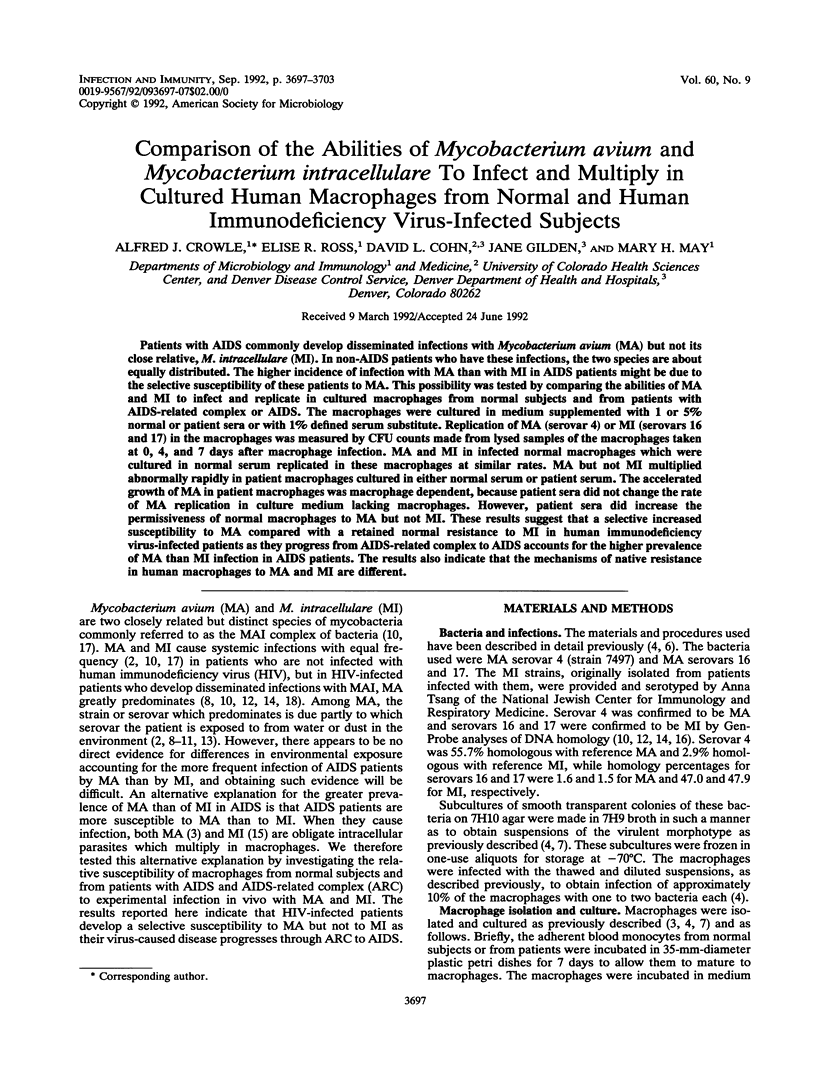
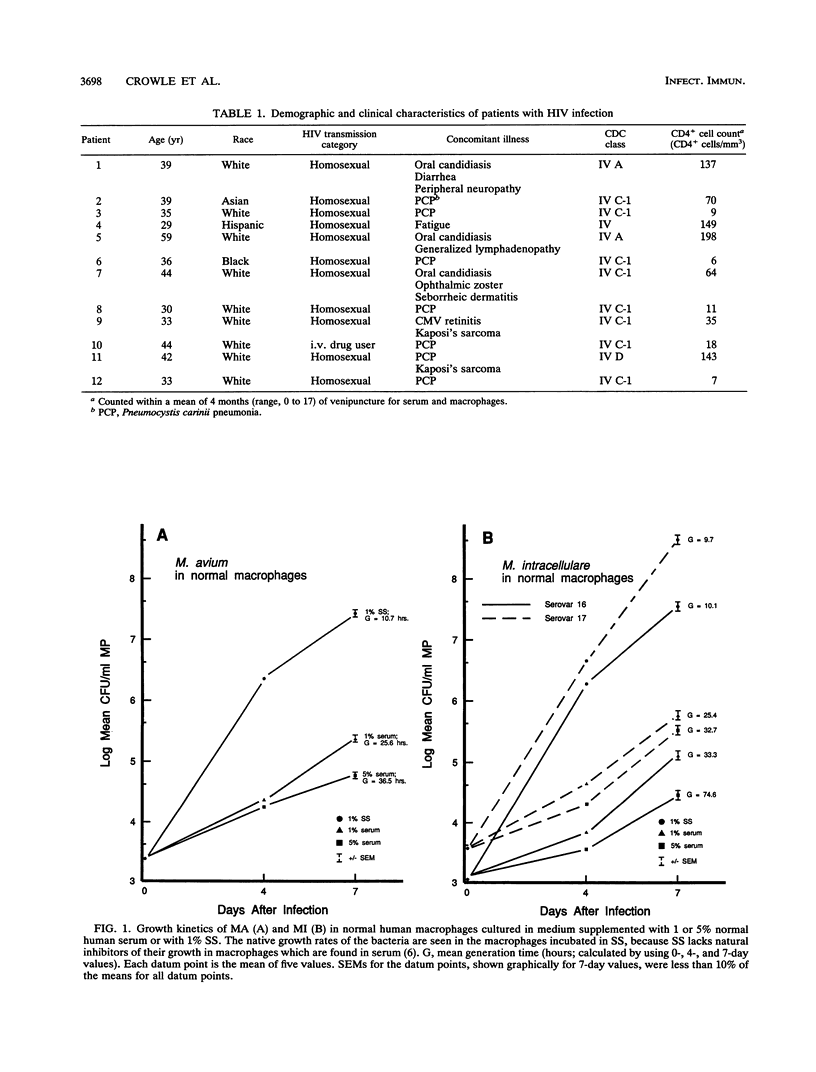
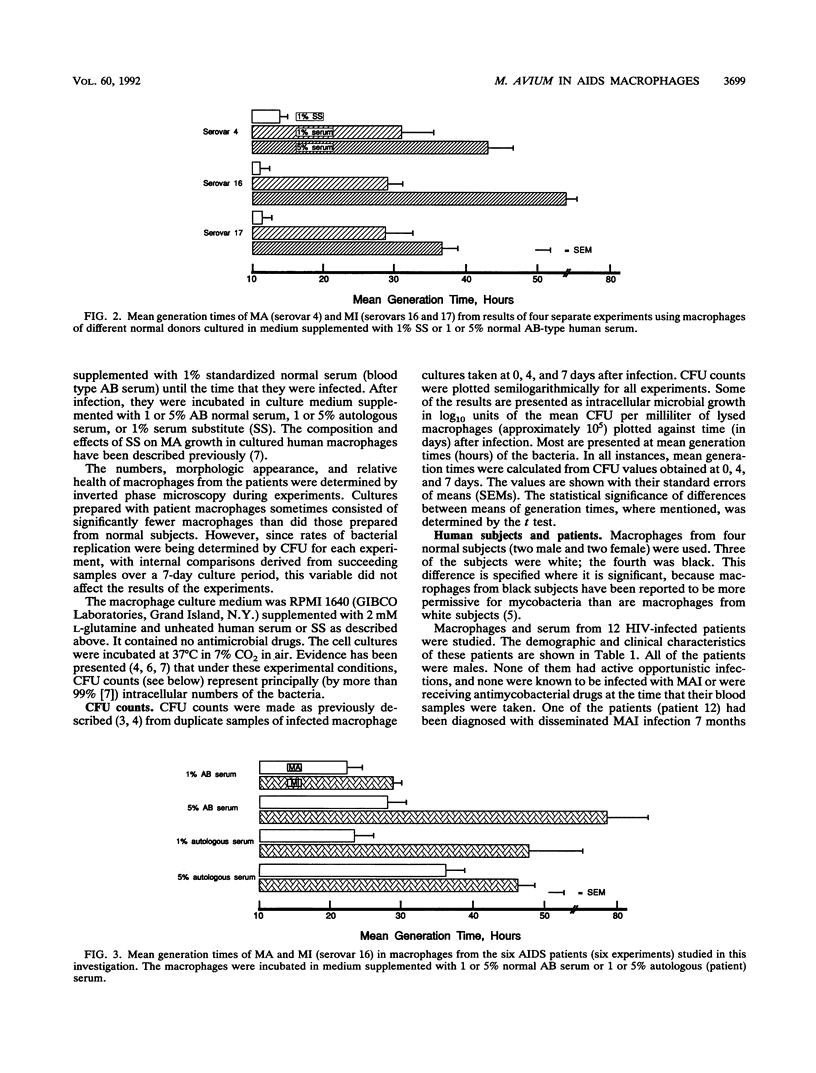
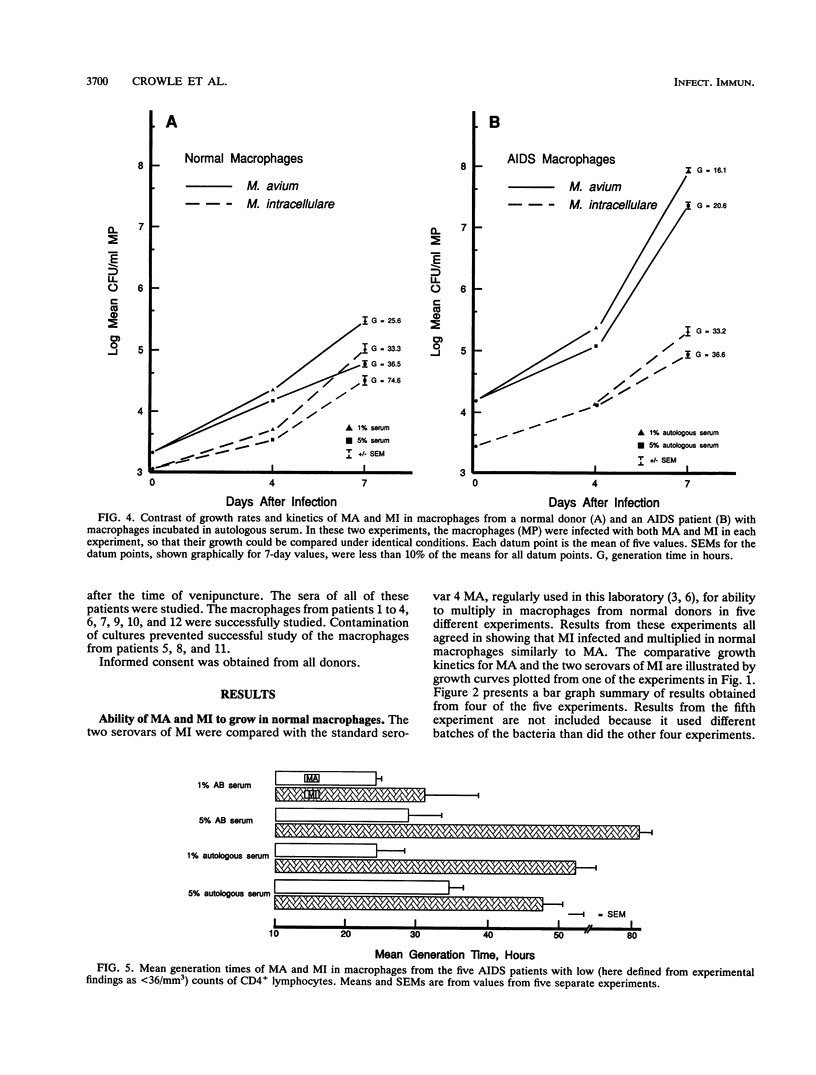
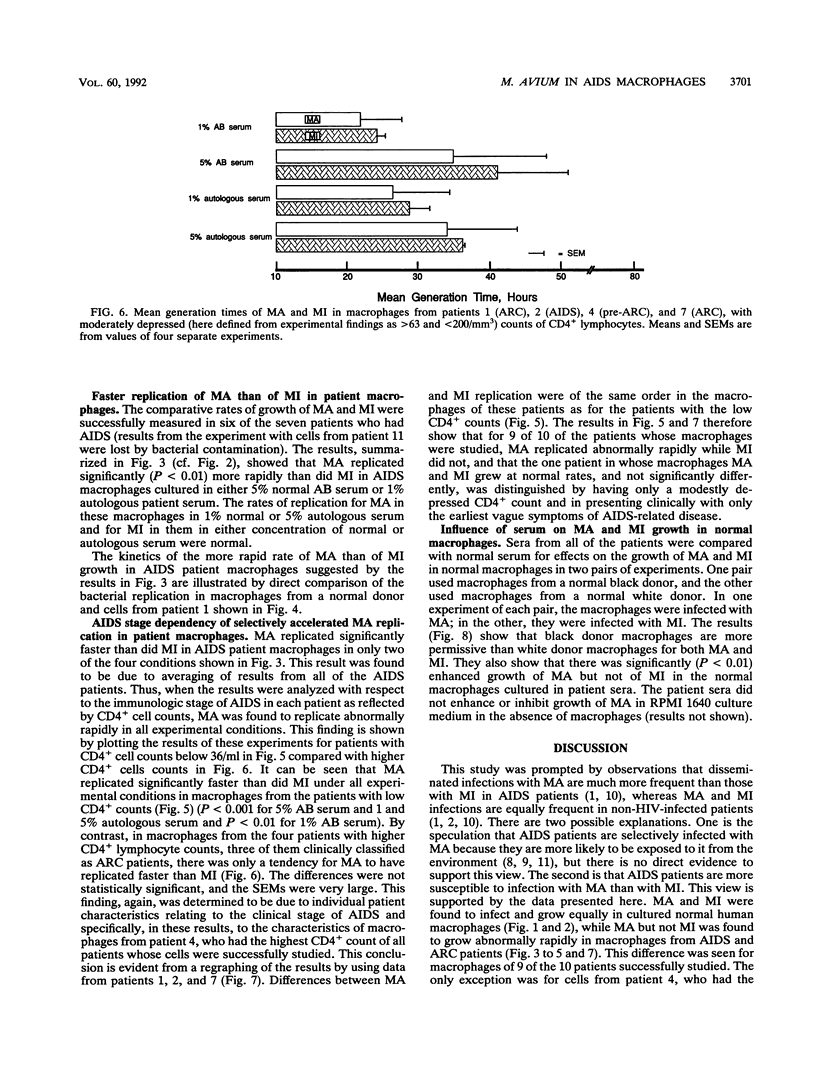
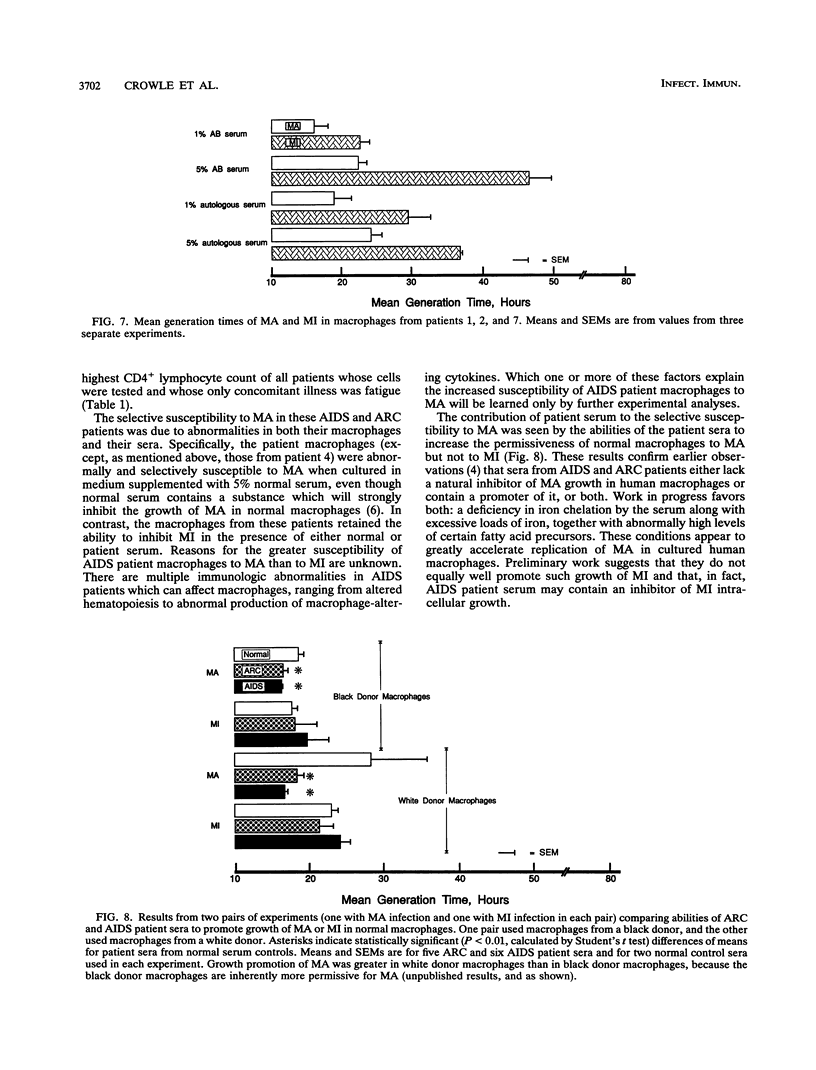
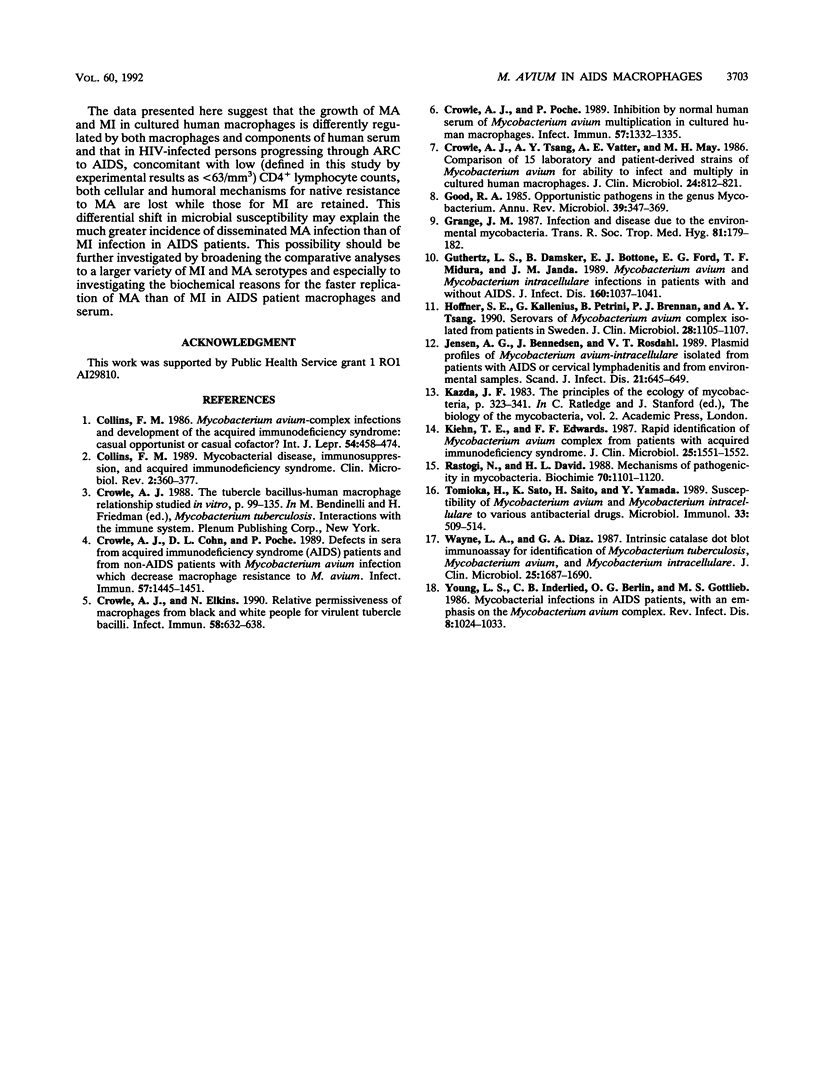
Selected References
These references are in PubMed. This may not be the complete list of references from this article.
- Collins F. M. Mycobacterial disease, immunosuppression, and acquired immunodeficiency syndrome. Clin Microbiol Rev. 1989 Oct;2(4):360–377. doi: 10.1128/cmr.2.4.360. [DOI] [PMC free article] [PubMed] [Google Scholar]
- Collins F. M. Mycobacterium avium-complex infections and development of the acquired immunodeficiency syndrome: casual opportunist or causal cofactor? Int J Lepr Other Mycobact Dis. 1986 Sep;54(3):458–474. [PubMed] [Google Scholar]
- Crowle A. J., Cohn D. L., Poche P. Defects in sera from acquired immunodeficiency syndrome (AIDS) patients and from non-AIDS patients with Mycobacterium avium infection which decrease macrophage resistance to M. avium. Infect Immun. 1989 May;57(5):1445–1451. doi: 10.1128/iai.57.5.1445-1451.1989. [DOI] [PMC free article] [PubMed] [Google Scholar]
- Crowle A. J., Elkins N. Relative permissiveness of macrophages from black and white people for virulent tubercle bacilli. Infect Immun. 1990 Mar;58(3):632–638. doi: 10.1128/iai.58.3.632-638.1990. [DOI] [PMC free article] [PubMed] [Google Scholar]
- Crowle A. J., Poche P. Inhibition by normal human serum of Mycobacterium avium multiplication in cultured human macrophages. Infect Immun. 1989 Apr;57(4):1332–1335. doi: 10.1128/iai.57.4.1332-1335.1989. [DOI] [PMC free article] [PubMed] [Google Scholar]
- Crowle A. J., Tsang A. Y., Vatter A. E., May M. H. Comparison of 15 laboratory and patient-derived strains of Mycobacterium avium for ability to infect and multiply in cultured human macrophages. J Clin Microbiol. 1986 Nov;24(5):812–821. doi: 10.1128/jcm.24.5.812-821.1986. [DOI] [PMC free article] [PubMed] [Google Scholar]
- Good R. C. Opportunistic pathogens in the genus Mycobacterium. Annu Rev Microbiol. 1985;39:347–369. doi: 10.1146/annurev.mi.39.100185.002023. [DOI] [PubMed] [Google Scholar]
- Grange J. M. Infection and disease due to the environmental mycobacteria. Trans R Soc Trop Med Hyg. 1987;81(2):179–182. doi: 10.1016/0035-9203(87)90206-9. [DOI] [PubMed] [Google Scholar]
- Guthertz L. S., Damsker B., Bottone E. J., Ford E. G., Midura T. F., Janda J. M. Mycobacterium avium and Mycobacterium intracellulare infections in patients with and without AIDS. J Infect Dis. 1989 Dec;160(6):1037–1041. doi: 10.1093/infdis/160.6.1037. [DOI] [PubMed] [Google Scholar]
- Hoffner S. E., Källenius G., Petrini B., Brennan P. J., Tsang A. Y. Serovars of Mycobacterium avium complex isolated from patients in Sweden. J Clin Microbiol. 1990 Jun;28(6):1105–1107. doi: 10.1128/jcm.28.6.1105-1107.1990. [DOI] [PMC free article] [PubMed] [Google Scholar]
- Jensen A. G., Bennedsen J., Rosdahl V. T. Plasmid profiles of mycobacterium avium/intracellulare isolated from patients with AIDS or cervical lymphadenitis and from environmental samples. Scand J Infect Dis. 1989;21(6):645–649. doi: 10.3109/00365548909021692. [DOI] [PubMed] [Google Scholar]
- Kiehn T. E., Edwards F. F. Rapid identification using a specific DNA probe of Mycobacterium avium complex from patients with acquired immunodeficiency syndrome. J Clin Microbiol. 1987 Aug;25(8):1551–1552. doi: 10.1128/jcm.25.8.1551-1552.1987. [DOI] [PMC free article] [PubMed] [Google Scholar]
- Rastogi N., David H. L. Mechanisms of pathogenicity in mycobacteria. Biochimie. 1988 Aug;70(8):1101–1120. doi: 10.1016/0300-9084(88)90272-6. [DOI] [PubMed] [Google Scholar]
- Tomioka H., Sato K., Saito H., Yamada Y. Susceptibility of Mycobacterium avium and Mycobacterium intracellulare to various antibacterial drugs. Microbiol Immunol. 1989;33(6):509–514. doi: 10.1111/j.1348-0421.1989.tb02000.x. [DOI] [PubMed] [Google Scholar]
- Wayne L. G., Diaz G. A. Intrinsic catalase dot blot immunoassay for identification of Mycobacterium tuberculosis, Mycobacterium avium, and Mycobacterium intracellulare. J Clin Microbiol. 1987 Sep;25(9):1687–1690. doi: 10.1128/jcm.25.9.1687-1690.1987. [DOI] [PMC free article] [PubMed] [Google Scholar]
- Young L. S., Inderlied C. B., Berlin O. G., Gottlieb M. S. Mycobacterial infections in AIDS patients, with an emphasis on the Mycobacterium avium complex. Rev Infect Dis. 1986 Nov-Dec;8(6):1024–1033. doi: 10.1093/clinids/8.6.1024. [DOI] [PubMed] [Google Scholar]


